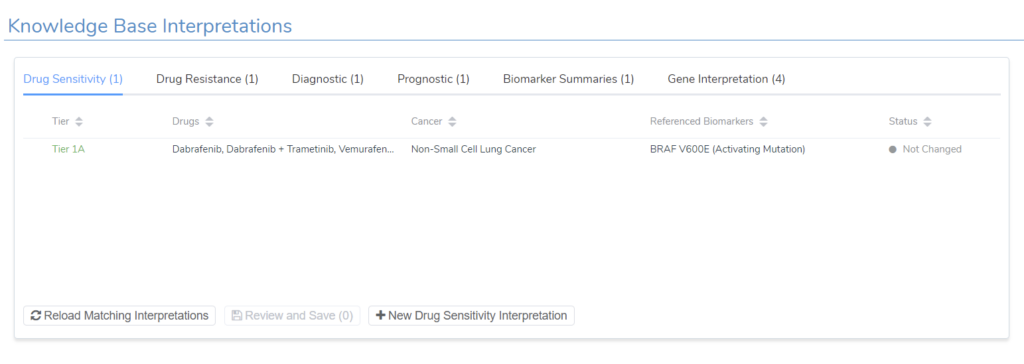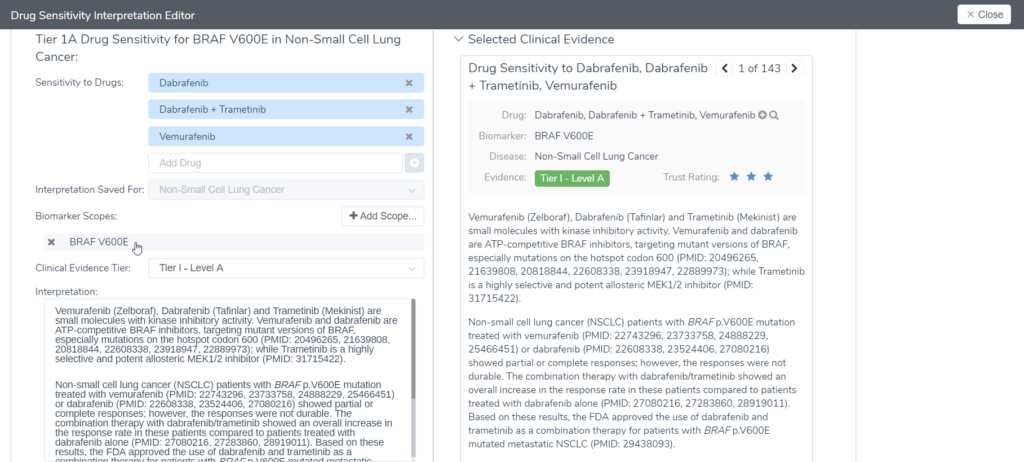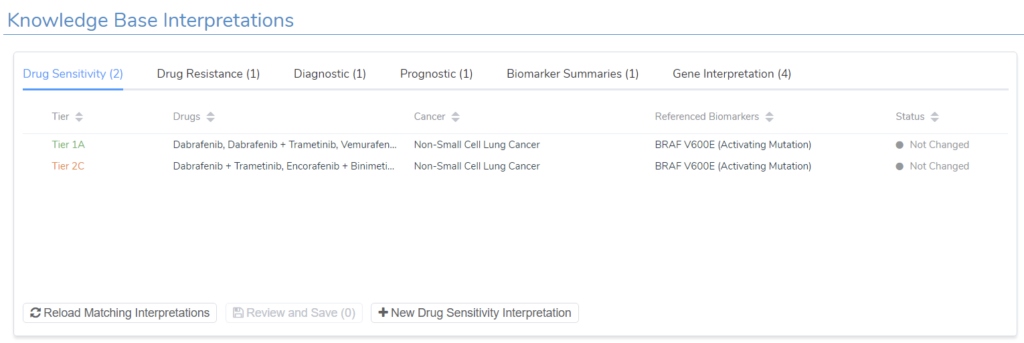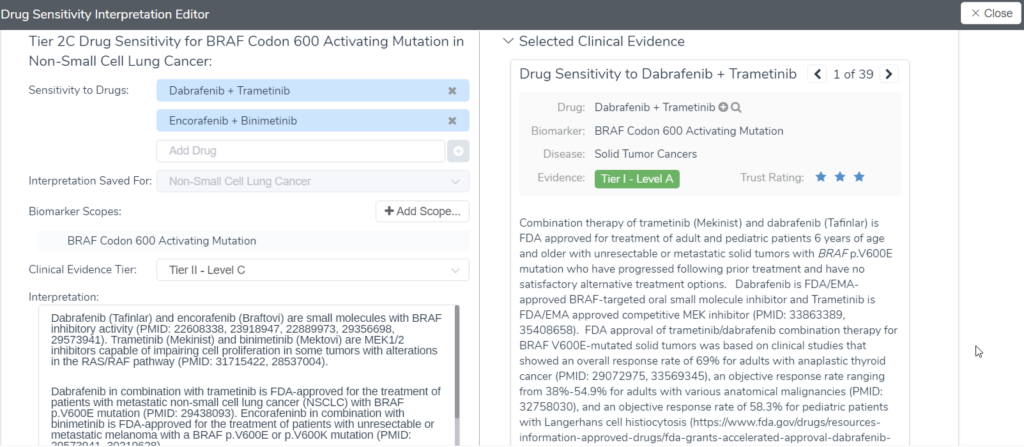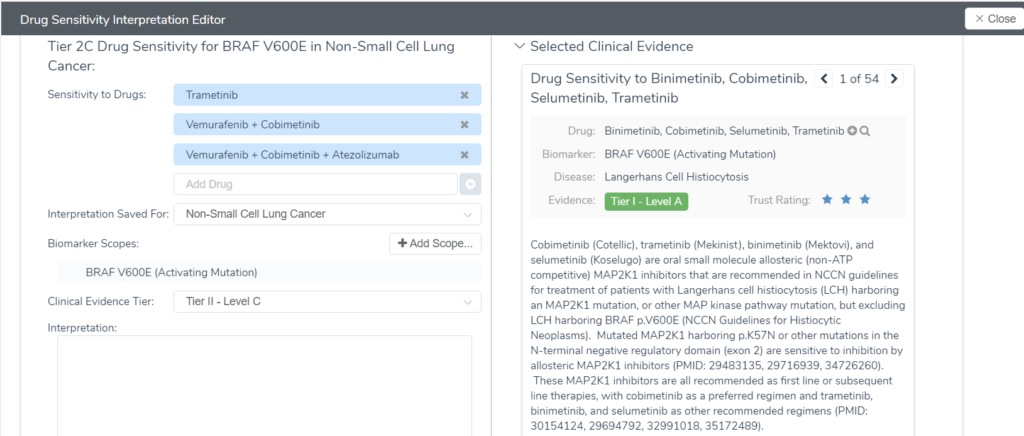
Discover the power of VSClinical’s Interpretation Match Behavior options for managing the scope of somatic variants in cancer reporting, enabling clinical teams to make informed treatment decisions.
Multiple interpretations can apply to a single biomarker or tumor type. In some circumstances, a clinical team may only want to report the most relevant and significant biomarker, treatment, diagnosis, or prognosis interpretations for a sample. In other situations, they may like to consider all the options and not risk losing out on potentially useful information, treatments, or clinical trials. VSClinical has created options for managing the scope of somatic variants when reporting on specific cancer types. In this article, we will explore the Interpretation Match Behavior options, which determine how wide or narrow the scope of interpretations will be.
Managing the scope of somatic variants that you report will be done prior to starting an evaluation in VSClinical AMP. The Interpretation Match Behavior options are found in the General tab of the Evaluation Options.
These options will determine which existing interpretations are auto-populated into your evaluation from the Cancer Interpretations catalog. This catalog includes existing interpretations from our Golden Helix Cancer Knowledge Base (CancerKB) or new locally stored interpretations added by the user. The user can choose one of three different interpretation matching heuristics:
- Match Best: Select the single best matching previous interpretation for the sample tissue type.
- Match All: Select all previous interpretations that match the biomarker scope for the sample tissue type.
- Match All Including Other Tumor Types: Select all previous interpretations that match the biomarker scope for the sample tissue type, along with tier I drug interpretations that match the biomarker scope for other tissue types.
The interpretation matching behavior is based on the interpretation’s region, scope and impact. The region refers to a gene, exon, codon, or specific variant locus. An interpretation’s impact provides a high-level description of the variant’s expected effect on the protein product and may be one of six values:
- Unknown
- Activating
- Loss
- Loss of Function
- Gain of Function
- Negative Finding
The scope refers to the type of variant, which may be any of the following:
- Mutation
- Amplification
- Deletion
- Insertion
- Loss of Heterozygosity
- Trincation
- Nonsense
- Splice mutation
- Skipping
- Missense
- Noncoding mutation
- Silent mutation
The overall scope of the annotation is type of biomarker that the interpretation will match against, whether that is a specific variant, a subset of variants of a specified type, or all variants in the associated region.
Because multiple interpretations may match with an individual biomarker or tumor type, VSClinical ranks matching interpretations by specificity to determine the best match. Interpretations for a specific variant are the most exact and are always preferred over other matching interpretations. Regional interpretations are ranked based on size, with smaller regions being preferred over larger regions. For example, an interpretation written for the BRAF codon 600 will always be chosen before a more general interpretation for all activating mutations in the BRAF gene.
The following examples using the BRAF gene will illustrate the utility of the Interpretation Match Behavior function for managing the scope of somatic variants reported in VSClinical.
After selecting Match Best and importing the BRAF V600E biomarker into an evaluation for non-small cell lung cancer (NSCLC), the Tier1 interpretation from CancerKB for the Dabrafenib, Trametinib, and Vemurafenib drug combo will auto-populate the Drug Sensitivity section.
This interpretation is specifically for the BRAF V600E biomarker, and this is what is seen in the field for biomarker scope.
Selecting Match All will automatically bring in two interpretations for BRAF V600E from our CancerKB. The addition is a Tier 2 Drug Sensitivity interpretation related to the drug combo Dabrafenib, Trametinib, Ecorafenib, and Binimetinib.
This Tier 2 interpretation has BRAF codon 600 Activating Mutation as the biomarker scope. Specifically, the drugs are being investigated in this cancer type but not yet FDA-approved or supported by well-powered consensus studies.
Lastly, selecting Match All Including Other Tissue Types is the most permissive setting and auto-populates the Drug Sensitivity section with the Tier 1 and 2 options seen previously, but also 3 more Tier 2 options that are Tier 1 for other cancer types.
In the example shown below, the drug combination has a Tier 1 interpretation for the BRAF V600E biomarker scope in Langerhans Cell Histiocytosis.
The ability to toggle between these Interpretation Match Behavior options gives the user flexibility, and this is important because it allows specificity when desired but also allows a patient’s clinical care team to be aware of more options in instances where the most specific treatments might not have any available or feasible clinical trials.
Thanks for reading this article, and please reach out to us at support@goldenhelix.com if you have any questions or comments regarding this topic.

